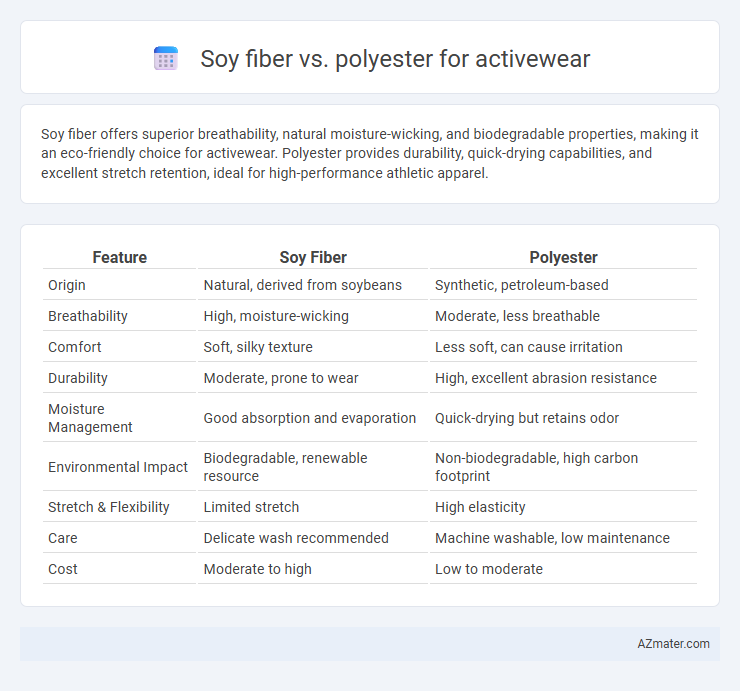Soy fiber offers superior breathability, natural moisture-wicking, and biodegradable properties, making it an eco-friendly choice for activewear. Polyester provides durability, quick-drying capabilities, and excellent stretch retention, ideal for high-performance athletic apparel.
Table of Comparison
| Feature | Soy Fiber | Polyester |
|---|---|---|
| Origin | Natural, derived from soybeans | Synthetic, petroleum-based |
| Breathability | High, moisture-wicking | Moderate, less breathable |
| Comfort | Soft, silky texture | Less soft, can cause irritation |
| Durability | Moderate, prone to wear | High, excellent abrasion resistance |
| Moisture Management | Good absorption and evaporation | Quick-drying but retains odor |
| Environmental Impact | Biodegradable, renewable resource | Non-biodegradable, high carbon footprint |
| Stretch & Flexibility | Limited stretch | High elasticity |
| Care | Delicate wash recommended | Machine washable, low maintenance |
| Cost | Moderate to high | Low to moderate |
Introduction: The Rise of Sustainable Activewear
Soy fiber, derived from soybean protein, offers a sustainable alternative to traditional polyester in activewear due to its biodegradability and moisture-wicking properties. Polyester, a synthetic fiber produced from petroleum, dominates the activewear market for its durability and stretch but raises environmental concerns due to microplastic pollution. The rise of sustainable activewear reflects growing consumer demand for eco-friendly materials like soy fiber that combine performance with environmental responsibility.
What is Soy Fiber?
Soy fiber, also known as vegetable cashmere, is a sustainable textile fiber derived from the byproducts of soybean processing, offering a soft, breathable, and biodegradable alternative to synthetic materials like polyester. It naturally absorbs moisture and provides excellent comfort in activewear, making it ideal for sweat-wicking and temperature regulation during workouts. Compared to polyester, soy fiber is eco-friendly with a lower environmental footprint and better biodegradability while maintaining durability and shape retention for activewear applications.
Understanding Polyester: The Industry Standard
Polyester, a synthetic fiber derived from petroleum, dominates activewear due to its exceptional durability, moisture-wicking properties, and quick-drying capabilities, making it ideal for high-intensity activities. Its resistance to shrinking, stretching, and abrasion ensures longevity in performance garments, while engineered variations like recycled polyester contribute to sustainability goals within the textile industry. Despite its environmental drawbacks, polyester maintains a competitive edge over natural fibers such as soy fiber by offering superior elasticity and color retention, crucial for maintaining activewear quality during repeated use and washes.
Comfort and Breathability Compared
Soy fiber offers superior softness and moisture-wicking properties, enhancing comfort for activewear by allowing better airflow and quick drying compared to polyester. Polyester, while durable and lightweight, tends to retain heat and moisture, potentially causing discomfort during intense workouts. The natural fiber composition of soy fiber promotes breathability and reduces skin irritation, making it a preferred choice for sensitive skin in activewear applications.
Moisture-Wicking and Quick-Drying Abilities
Soy fiber offers excellent moisture-wicking properties due to its natural hydrophilic structure, allowing it to absorb and release sweat efficiently during workouts. Polyester, a synthetic material, excels in quick-drying capabilities by repelling moisture and facilitating rapid evaporation, making it ideal for high-intensity activities. While soy fiber ensures breathability and comfort through moisture absorption, polyester provides superior durability and faster drying times, crucial for activewear performance.
Durability and Longevity in Performance
Soy fiber offers natural breathability and moisture-wicking properties but generally has lower durability compared to polyester, which excels in maintaining fabric integrity under frequent washing and intense physical activity. Polyester's synthetic composition ensures superior resistance to abrasion, stretching, and color fading, making it a preferred choice for long-lasting activewear. For performance longevity, polyester provides consistent shape retention and durability, while soy fiber blends may require more delicate care to avoid premature wear.
Environmental Impact: Soy Fiber vs Polyester
Soy fiber is biodegradable and derived from renewable resources, significantly reducing its environmental footprint compared to polyester, which is petroleum-based and non-biodegradable. Polyester production emits higher greenhouse gases and contributes to microplastic pollution in waterways, whereas soy fiber decomposes naturally without leaving harmful residues. Choosing soy fiber for activewear supports sustainable fashion by minimizing resource consumption and long-term environmental damage.
Skin Sensitivity and Allergy Considerations
Soy fiber, derived from natural soybean proteins, offers exceptional softness and breathability, making it ideal for those with sensitive skin prone to irritation or allergies. Polyester, a synthetic material, can trap moisture and heat, potentially causing discomfort or allergic reactions for individuals with skin sensitivities. Choosing soy fiber activewear can reduce the risk of dermatitis and promote better skin health during exercise.
Cost and Availability in the Activewear Market
Soy fiber, derived from natural soybean protein, is generally more expensive and less widely available in the activewear market compared to polyester, a synthetic fiber known for its affordability and mass production. Polyester dominates the activewear industry due to its cost-effectiveness, durability, and broad supply chain, making it the preferred choice for large-scale manufacturing. The limited availability and higher price point of soy fiber restrict its use primarily to niche sustainable and eco-friendly activewear brands.
Choosing the Best Fiber for Your Active Lifestyle
Soy fiber offers natural breathability, moisture-wicking properties, and sustainable benefits ideal for activewear, while polyester provides durability, quick-drying capabilities, and resistance to shrinking and stretching. For eco-conscious consumers, soy fiber's biodegradable nature and softness enhance comfort during workouts, whereas polyester's high tensile strength and ease of maintenance suit intense physical activities. Balancing performance needs and environmental impact helps in choosing the best fiber for your active lifestyle.

Infographic: Soy fiber vs Polyester for Activewear
 azmater.com
azmater.com